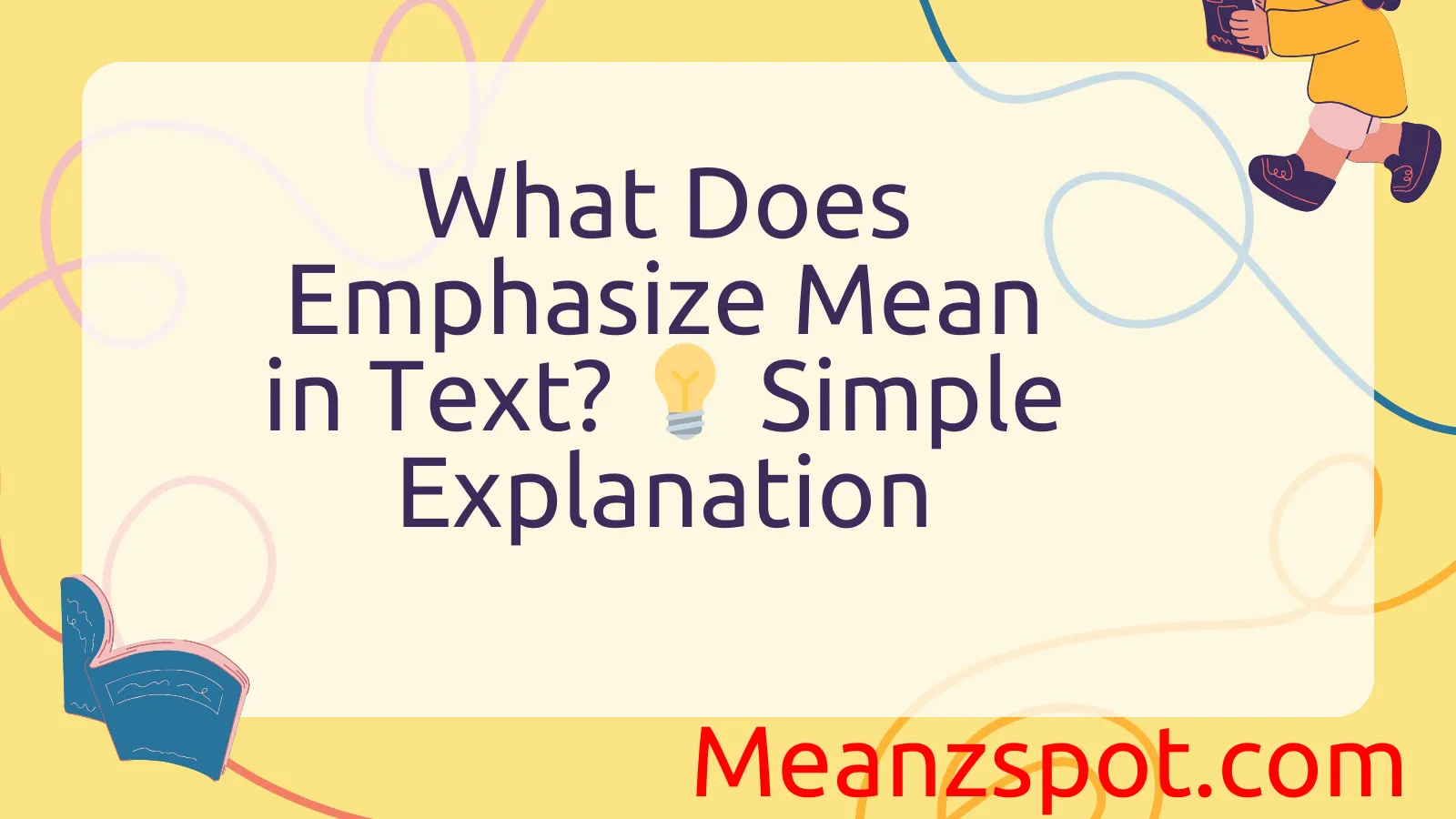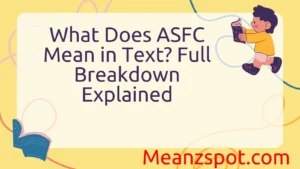When someone tells you to “emphasize” something in text, they simply mean to give it extra importance or make it stand out so the reader doesn’t miss it. In writing, emphasize can be shown in many ways—through bold words, italics, underlining, CAPITAL LETTERS, or even repeating an idea for effect. It’s like highlighting a part of your message so the person reading knows it matters most.
Whether you’re texting a friend, writing an essay, or posting online, knowing how to emphasize properly makes your message clearer, stronger, and more persuasive.
Definitions & Meaning
To emphasize something in text means to give it special importance or attention, often to highlight its significance or urgency. Emphasis is a rhetorical and stylistic tool used by writers to guide the reader’s focus, making sure the most crucial points are understood and retained.
In grammatical and linguistic terms, emphasis can be expressed through several methods:
- Formatting: Bold, italics, underlining, or ALL CAPS.
- Syntax: Word placement or sentence structure, such as front-loading a sentence with an important point.
- Repetition: Repeating a word or phrase for effect.
- Punctuation: Using exclamation marks or ellipses for dramatic pauses or intensity.
For example:
- “This is important.” (Plain)
- “This is important.” (With emphasis)
Emphasis can be subtle or overt, depending on the writer’s intent. In literature, poets often emphasize ideas through meter and rhythm, while journalists may emphasize facts through headlines and ledes. In personal communication, such as texting, emphasis helps convey tone, especially when vocal cues are absent.
Ultimately, to emphasize in text is to control the reader’s attention, reinforcing key messages and helping to deliver meaning more effectively.
Origins & History
The concept of emphasis has its roots in both classical rhetoric and the natural evolution of language. The word emphasize is derived from the Greek term emphainein, meaning “to show, indicate, or exhibit.” It was adapted into Latin as emphasis, and eventually into English in the 16th century, initially as a rhetorical term used to describe a forceful expression of ideas.
Classical orators like Cicero and Aristotle discussed emphasis as a key rhetorical strategy. In ancient times, speakers relied on vocal stress and gestures to add emphasis. With the invention of the printing press and the rise of written communication, writers began experimenting with textual methods to replicate spoken emphasis—using punctuation, capitalization, and later, typeface changes.
In modern literature and journalism, emphasis evolved through typesetting innovations. Italics became a common way to stress a word, while boldface was used for headlines and significant terms. The digital age introduced new tools—like emoji, caps lock, and formatting codes—to signal importance or emotion.
Understanding this history helps us see how emphasis has always played a central role in communication, adapting to each new medium while preserving its core purpose: to ensure that certain ideas stand out more than others.
Usage in Different Contexts
1. Social Media:
On platforms like Twitter, Instagram, or TikTok, users often use ALL CAPS, emojis, or repeated punctuation (!!!) to emphasize emotions or opinions. For example:
“I am SO EXCITED for this concert!!! 🎉🎶”
This type of emphasis adds personality and tone, making posts more engaging and expressive.
2. Professional Communication:
In emails, reports, or presentations, emphasis is usually more restrained. Professionals rely on formatting (bold or italic) or layout (bullet points, headings) to draw attention. For example:
“Please submit your reports by Friday.”
This adds clarity without sounding overly emotional.
3. Literature and Creative Writing:
Authors use sentence structure, word choice, and typography for emphasis. For instance, a sudden short sentence in a long paragraph can stand out dramatically.
“Everything was calm. Silent. Then—bang.”
4. Academic Writing:
Emphasis must remain objective and subtle. Scholars may use phrases like “It is important to note…” or “Significantly, the results show…” to draw attention without overt formatting.
5. Pop Culture:
In memes or fan forums, exaggeration is often the point. Capitalization, asterisks, or mock tone can emphasize sarcasm or excitement.
“literally no one: Me: I NEED COFFEE RIGHT NOW.”
Each context uses emphasis differently based on tone, audience, and medium. What’s playful on social media may seem unprofessional in a business setting. Adapting your emphasis to fit the situation is key to effective communication.
Common Misunderstandings & Clarifications
1. Emphasis ≠ Shouting:
While using ALL CAPS can imply shouting in digital communication, it doesn’t always mean aggression. In casual contexts, it can simply express excitement. However, overuse can still be misread.
2. Emphasis Isn’t Always Visual:
Not all emphasis comes from formatting. Word order and repetition can be just as powerful. For example, “She alone knew the truth” emphasizes the subject subtly.
3. Too Much Emphasis Dilutes Impact:
If everything is emphasized, nothing stands out. Overusing bold or caps can overwhelm readers and reduce clarity.
4. Emphasis Can Vary by Culture and Platform:
What feels emphatic in one culture or platform may be neutral in another. Emojis, for instance, may be seen as unprofessional in formal emails but are perfectly acceptable in group chats.
5. It’s Not Always Intentional:
Sometimes, readers perceive emphasis where none was intended, especially in short texts or ambiguous phrasing. Tone can easily be misread without vocal cues.
Understanding these nuances helps avoid miscommunication and ensures that your emphasis enhances rather than detracts from your message.
Alternatives & Synonyms
If you’re looking to express the idea of emphasis without using the word “emphasize,” several alternatives and synonyms can be used depending on context:
- Highlight: “Let me highlight the main issue.”
- Stress: “She stressed the importance of being on time.”
- Underscore: “The data underscores the urgency of action.”
- Accentuate: “The report accentuates the strengths of the team.”
- Draw attention to: “He drew attention to the discrepancies.”
- Point out: “I want to point out a few concerns.”
Each synonym carries a slightly different tone or implication. For example, highlight often suggests visual emphasis, while stress and underscore imply strong importance. Choosing the right word can enhance clarity and tone in both casual and formal writing.
Frequently Asked Questions (FAQ)
1. What does it mean to emphasize something in text?
To emphasize something in text means to give it special attention or importance, often to make it stand out to the reader.
2. How can I add emphasis in writing?
You can emphasize by using bold, italics, all caps, repetition, sentence structure, punctuation, or strategic word choice.
3. Is using ALL CAPS a good way to emphasize?
It can be effective in casual contexts, like texting or social media, but may come off as shouting in professional writing. Use sparingly.
4. What’s the difference between emphasis and tone?
Emphasis is about what stands out or is highlighted, while tone refers to the overall attitude or feeling of the writing.
5. Can overemphasizing weaken my message?
Yes. If everything is emphasized, the reader won’t know what’s truly important. Use emphasis selectively for best impact.
6. Are there cultural differences in how emphasis is used?
Absolutely. In some cultures, visual emphasis may be seen as too informal or aggressive, while in others, it’s standard practice.
7. How do I emphasize without formatting tools?
Use word order, repetition, or phrases like “It is essential that…” to create emphasis even in plain text formats.
Conclusion
Emphasis is a powerful tool in communication, guiding the reader’s focus and shaping the message’s tone and impact. Whether you’re crafting an email, writing a novel, or posting on social media, understanding how to emphasize effectively can elevate your writing. From its classical origins in rhetoric to modern digital expressions, emphasis continues to adapt while maintaining its core purpose: making sure important ideas are noticed and remembered.
By using emphasis thoughtfully and sparingly, you ensure your key points don’t get lost in the noise. So next time you write, ask yourself—not just what you’re saying, but how you’re making it stand out.



